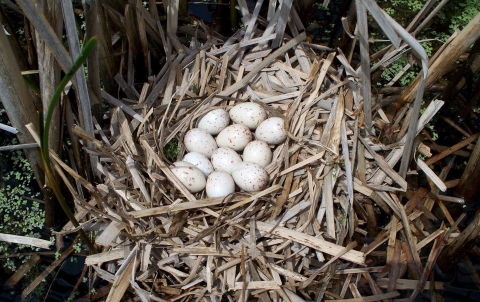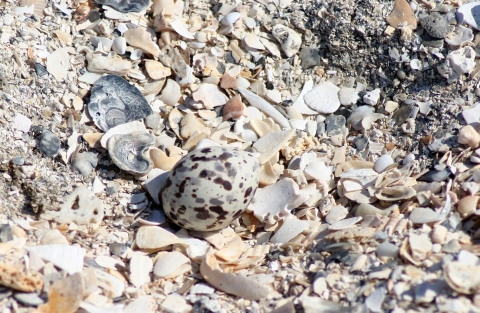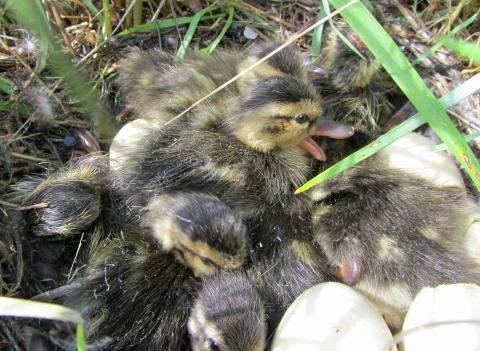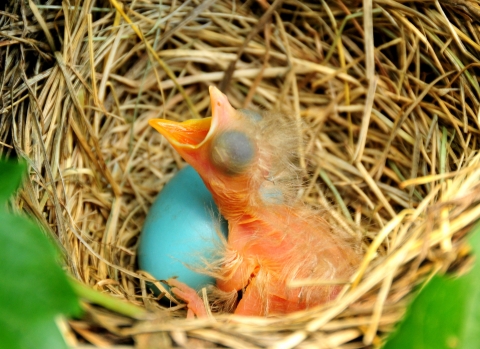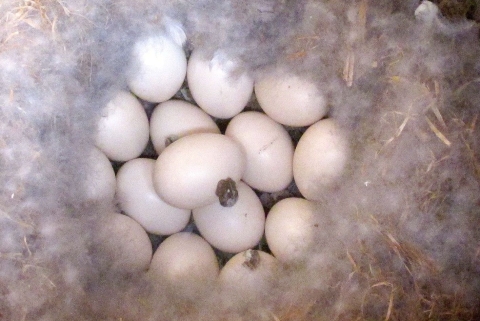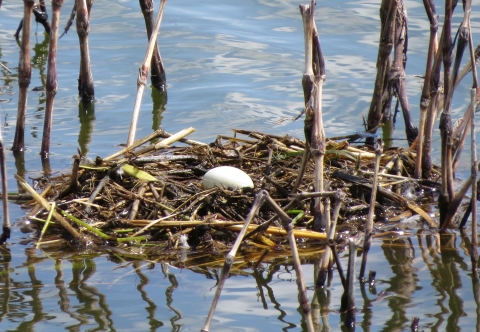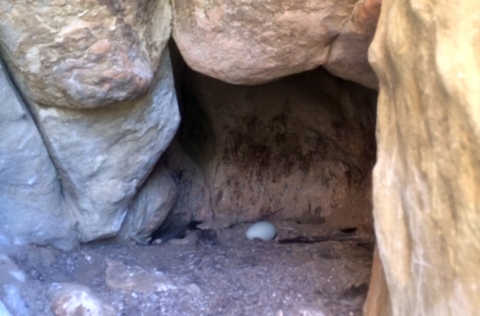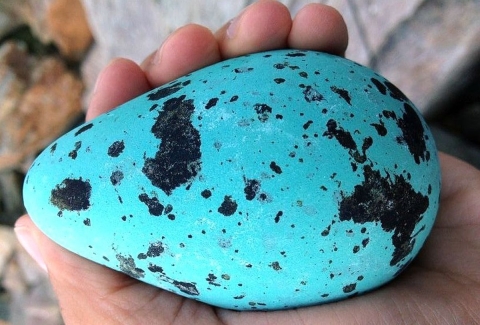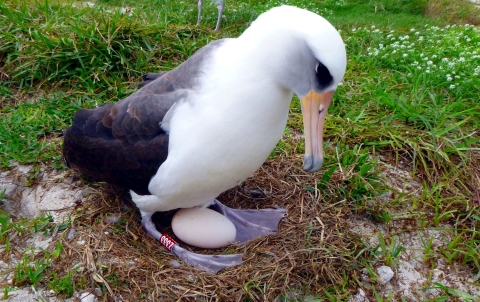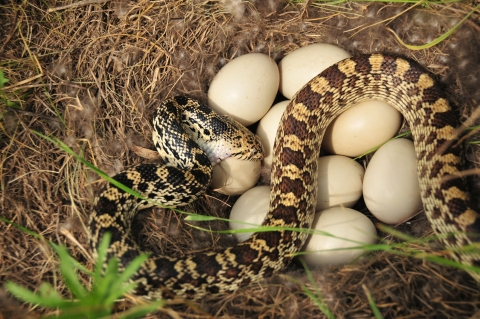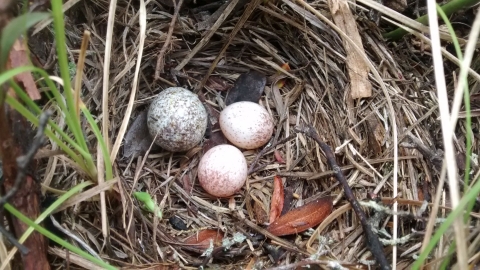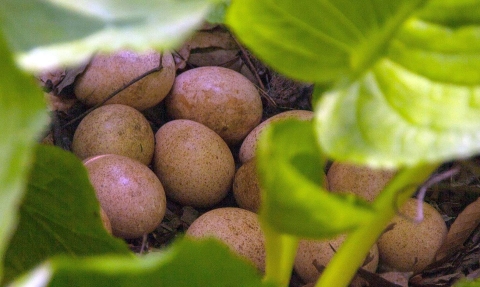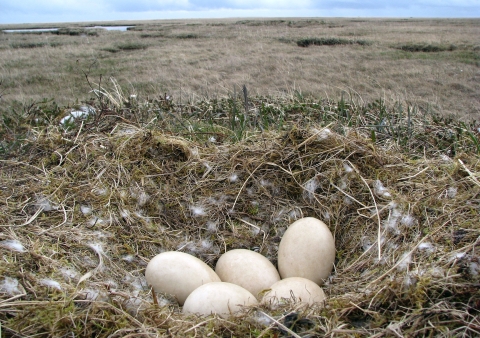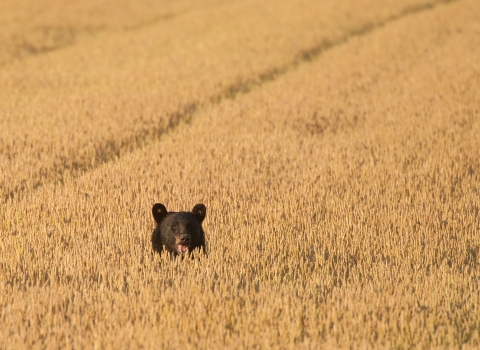When spring is in the air, eggs are in nests at national wildlife refuges from coast to coast and beyond.
The dictionary defines the word “egg” as follows: “An oval or round object laid by a female bird, reptile, fish, or invertebrate, usually containing a developing embryo. The eggs of birds are enclosed in a chalky shell, while those of reptiles are in a leathery membrane.”
This story is all about eggs, in particular bird eggs.
We asked Paul Baicich, co-author of “Nests, Eggs and Nestlings of North American Birds” and a Friends of the Migratory Bird/Duck Stamp board member, to point out a few distinctive characteristics of eggs.
There is a reason some eggs are white and some are colored, Baicich says.
White eggs in the wild belong predominately to cavity nesters – birds that nest in deep holes in trees or terrain. Because the eggs are white, the adult birds can see them in the dark cavities.
Colored eggs in the wild generally belong to birds that nest in comparatively open areas on the ground, Baicich says. Because eggs in ground nests have color, they are harder for predators to find.
Examples of cavity nesters are woodpeckers, owls, kestrels and some flycatchers and swallows. Ground nesters include plovers, gulls and most ducks, geese and swans.
There are two primary types of bird hatchlings: precocial and altricial.
Precocial birds hatch with feathers, with their eyes open, and pretty much ready to leave the nest and run around within hours. Ground nesters tend to be precocial. That’s necessary, Baicich says, so hatchlings can “get away from predators and follow mom and sometimes dad.”
Altricial birds hatch pretty much helpless. They hatch semi-naked or naked – with few feathers or no feathers. They usually are blind. They depend on the parents for food for a period of time. Cavity nesters tend to be altricial, but there are exceptions.
One well-known exception – one cavity nester that is precocial – is the wood duck. Wood ducks nest in existing tree cavities or human-built nest boxes. They cannot build their own cavities. Females lay a dozen or so bone-white eggs in cavity nests near wooded swamps, freshwater marshes, streams or rivers. The ducklings hatch with feathers and, as this video shows, jump out of the nesting cavity or box soon thereafter.
So, what are eggshells made of?
They are 95 percent calcium carbonate, says Baicich, “the same stuff that makes up seashells, corals and even pearls.” The remaining 5 percent consists of other elements that often give color.
The California condor almost certainly lays the largest eggs of any U.S. bird species, Baicich says, followed by the Laysan albatross. California condor eggs are about 110 millimeters long – or about 4.3 inches.
Hummingbirds have the smallest eggs among U.S. species. Calliope hummingbird eggs are 12 millimeters long – less than half an inch.
Generally speaking, Baicich says, “I think it is intuitive that the bigger the bird, the bigger the egg.”
Birds can nest in unusual places.
Chimney swifts build their nests on the inside walls of chimneys. The adults put twigs up against chimney bricks and use their saliva as glue. Their eggs are white. Baicich is not sure where chimney swifts nested before the invention of the chimney. He notes that chimney caps are a real problem for the species.
Auklets, murres, guillemots and other seabirds often lay their eggs on bare cliff ledges (with no nest) at places like Alaska Maritime National Wildlife Refuge and Oregon Islands National Wildlife Refuge. These eggs often are pyriform (pear-shaped and pointed). Scientists used to think eggs on cliffs evolved to be pyriform so they would be less likely to roll away than oval eggs are, but scientists don’t think that is the case anymore.
Some birds, such as belted kingfishers and green kingfishers, build burrows or take advantage of existing burrows on riverbank bluffs. Burrowing owls in the West will use abandoned prairie dog burrows, and in the Southeast they will use abandoned land tortoise sand burrows.
As with egg size, length of incubation period tends to correlate with the size of the bird.
Baicich estimates that the U.S. species with the longest incubation periods are Laysan albatross (62 to 66 days), black-footed albatross (65 days) and California condor (50-60 days). This video shows Wisdom, a Laysan albatross and the oldest known bird in the wild, laying an egg at Midway Atoll National Wildlife Refuge. Wisdom, who is at least 69 years old, has raised at least 10 chicks since 2006 and as many as 40 in her lifetime.
Surprisingly, tiny hummingbirds do not have the shortest incubation periods. Small passerines (songbirds) like yellow warblers, Lapland longspurs, common redpolls have the shortest incubation time at 10 to 12 days.
Predators and extreme weather conditions threaten the survival of bird eggs. Birds must protect incubating eggs from cats, snakes, foxes, weasels, skunks and raccoons. Often, the most aggressive predators are not native to an area. Extreme weather, flooding, drought, heat, cold and loss of habitat to human development and agriculture also adversely affect nesting success.
An odd hazard that the some eggs face is a phenomenon known as brood parasitism or avian parasitism. This occurs when a bird lays its egg or eggs in the nest of another bird and leaves the responsibility of rearing the offspring to the other bird.
Baicich points out that the brown-headed cowbird is particularly hazardous to the Kirtland’s warbler, an endangered bird found mostly in central Michigan. Brown-headed cowbirds often steal Kirtland’s warbler eggs.
Check out this video of a brown-headed cowbird laying an egg in a northern cardinal’s nest.
Some birds lay a single egg. Others lay clutches of eggs. Game species, such as gray partridges, chukars and ring-necked pheasants, generally lay the most eggs – 15 to 20 at a time. Wild turkeys lay clutches of eight to 12 eggs, and occasionally up to 20. In all of these cases, the birds hatch precocially (with feathers and ready to leave the nest), but typically only a few young survive to adulthood.
What should you do if you find an active, unattended nest containing eggs at national wildlife refuge national wildlife refuge
A national wildlife refuge is typically a contiguous area of land and water managed by the U.S. Fish and Wildlife Service for the conservation and, where appropriate, restoration of fish, wildlife and plant resources and their habitats for the benefit of present and future generations of Americans.
Learn more about national wildlife refuge or elsewhere?
If you’re not a wildlife professional, a certified volunteer or part of a citizen science data-collecting effort like Nestwatch, “just leave it alone!” says Baicich.
Without further disturbance, the eggs are more likely to hatch, and we may be lucky enough to enjoy a sight of the hatchlings one day.


